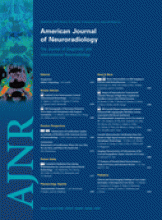The inherent separation of imaging and treatment modalities has contributed to time delays that are problematic in the management of stroke. Indeed, delays in treatment may be caused by multiple factors, some of which can be reduced.1 One of these factors is the time between imaging and initiation of treatment. This is especially true if one considers starting endovascular treatment in any patient. Thus, any kind of technologic progress in which imaging and treatment are combined is going to revolutionize stroke management. Indeed, flat panel technology can be used for radiologic examinations such as digital subtraction angiography (DSA). Recently, Söderman et al2 have shown that flat panel technology can also reconstruct CT images and, as we see in their article, can go 1 step further to provide CT angiography (CTA) and, spectacularly, perfusion CT (CTP).
Flat panel technology, which has been developed during the past decade, has just entered the clinical arena and has been shown to provide many imaging parameters in combination with the possibility of performing endovascular procedures. Very often, this technology has been used to provide high-resolution imaging of the brain vessels.
In this preliminary but important study, 2 the authors have examined 10 patients by flat panel technology; these patients also underwent CT and conventional angiography. Both imaging of the vasculature and perfusion imaging as obtained by flat panel technology provided satisfactory results.
While there may still be limitations to this technology regarding soft-tissue resolution, it is possible to distinguish gross hemorrhage, which might prevent thrombolysis or be a consequence of treatment. Also it will be possible to demonstrate other intracranial changes occurring during or immediately after the procedure. Anyone who has been using flat panel CT will acknowledge that the quality of the images at the moment very often resembles that of the early EMI scanners (Electric & Musical Industries Ltd., London, United Kingdom). However, there has been a constant evolution in both technique and image quality so that it is to be expected that in time images will be of standard CT quality. Gains in temporal and spatial resolution have often compensated for this reduction in imaging quality.
The angiographic images generated by both DSA and the CT are, of course, beyond criticism because we can obtain 3D datasets of the cerebral vasculature with the CT modules that are of superb quality. The capacity to also section the intracranial vessels axially is extremely helpful, especially in cases in which the exact anatomic relationships are assessed. We have also seen that flat panel detector angiography units can provide us with high-resolution datasets of flow, which can also be an enormous advantage if treatment of an underlying vascular malformation or aneurysm is being considered.
Radiation exposure, which is, at the moment, a hot topic in perfusion CT, is going to be critical here. Indeed, these patients will be subjected to many radiating imaging modalities during the same session. However, whereas the direct devastating effects of stroke are important to consider, flat panel technology, because inherently it was at least in part devised to reduce radiation exposure, should lend itself to reducing these worries.
Its capacity to also now add perfusion to the whole package is simply revolutionary, and the authors of this study,3 while limited in its number of patients, have done a superb job in developing and also implementing this combined DSA, CT, CTA, and CTP protocol. The combination of these techniques in 1 imaging unit will decisively reduce imaging time and thus improve treatment. While the method of Söderman et al2 for computation of cerebral blood volume is still somewhat rudimentary, they were able to obtain useful datasets.
Whether this approach will remain the only combination of multimodality imaging and therapy planning and monitoring in 1 setup remains to be seen because MR imaging researchers have been trying for decades to combine intravascular devices with imaging, and this combination could also be the next step, even though security measures for magnetic devices render the whole process time-consuming and thus limiting.4 However, when dealing with patients with acute stroke, the possibility of obtaining diffusion imaging additionally would be the real revolution. At the moment, however, this new flat panel−derived development is a giant step for neuroradiology and is as good as it gets.
- Copyright © American Society of Neuroradiology







